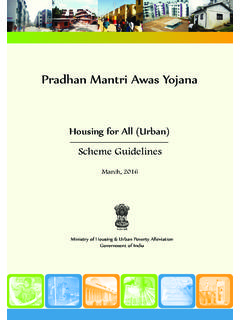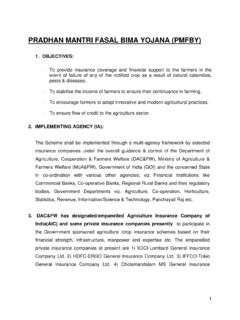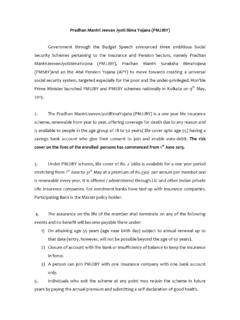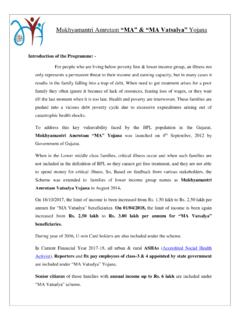Transcription of What India can do differently in agriculture - Tata …
1 R GopalakRishnan, Director, Tata sonsDR Ysp ThoRaT, Former Chairman, nabardWhat India can do differently in agricultureSarthak kriShi Yojana02A TATA kind of culTure2 The paper has been published by R Gopalakrishnan and Dr YSP Thorat. For comments or additional copies please write to or To download, please visit: and edited by The Information CompanyA TATA kind of culTure 3 what India can do differently in agricultureSarthak kriShi Yojana02A TATA kind of culTure4 agriculture will surely be of great importance in the coming years. It is crucial to appreciate this reality. Although agricultural growth has been excellent since 2000, over the past two years, it has slowed. Back-to-back below-average monsoons during the past two years have strongly affected the Indian economy. It is fair to say urgent attention is required in this sector. After all, the agriculture and allied sectors account for a major share of employment. Positive agricultural growth is also linked to positive politics, as is suggested by experiences of Gujarat, Madhya Pradesh and both come from very different professional backgrounds.
2 We have had a common interest in agriculture , farmers and rural India . Between us we share many years of rural exposure and luckily have experienced complementary facets. We have had a common association working on corporate boards. Our exposure of several years to Indian agriculture has enabled us to share perspectives about issues facing Indian agriculture and what India can do about questions on agriculture arise naturally. First, more than half the workforce 260 million people is deployed in agriculture and allied sectors. There is an urgent need to upgrade skills in agronomic practices, soil / water / pest / nutrient management and post-harvest technologies. Yet, in the national Foreworddiscourse on skill building we hear very little about upgrading agricultural skills. Second, India s agricultural exports account for about USD40 billion, which is 12-13% of India s exports. It surely has potential to increase if we can improve productivity and management systems.
3 Yet, there is very little talk about agricultural production in the Make in India programme. Third, there is urgent need to expand financial inclusion in India . This can be significantly advanced if the farmer awareness is increased to form farmer producer organisations (FPOs) under the Companies Act. Such organisations can also become employers of trained and skilled agriculture workers. Yet, the drive to increase FPOs in India is not clearly questions generated much discussion between us. We have been struck by the fact that India has outstanding experts in all aspects of agriculture farm economics, agricultural markets, finance and risk management, marketing of input and output, as well as science and technology. agriculture and farming are connected to livelihood and social mores, which makes them very complex, with interconnections among various we tried to answer three questions -1. Although the past couple of years have been difficult for Indian agriculture , has it performed well in this millennium?
4 2. Indian agriculture productivity does not compare well with other countries. what is the problem with Indian agriculture ?A TATA kind oF culTure 73. In agriculture we must do things differently . what can be a national framework to execute a mindful agriculture programme (Sarthak Krishi yojana ) by better co-ordination among independent agencies and institutions?Our conclusion is that agriculture does not suffer from a lack of ideas, funds or government initiatives. Current initiatives and institutions are fragmented and work in silos. There is need to work together, do things differently and get centres of expertise in credit, rural development, risk management, technology and training to work together. what could be strengthened is an integrated and holistic framework, which provides a managerial way of implementing ve tried to articulate an integrated framework in this paper and summarise key pillars of the framework. Many details remain, about which much has been written by experts.
5 If the framework is worthy, then the details can be worked out and an implementation plan can be ensure the success of Sarthak Krishi yojana , it should be a collaboratively driven project with the states, like Jan-Dhan yojana , Atal Pension yojana and Swachh Bharat Abhiyan. The nation may benefit by having a high level, collaborative organisation, like a Krishi Aayog, to articulate features and components of the pillars, seek consensus with states and 02A TATA kind oF culTure8 implement them as a comprehensive National Agricultural Mission. Such a move may instil enthusiasm in the sector and may invite of this paper have been presented at events organised by the Ahmedabad Management Association (April 2015), Bangalore International Centre (June 2015) and Bombay Chamber of Commerce and Industry (June 2015).We are grateful to several experts for contributions to this paper. To mention a few, we acknowledge the influence of Dr YK Alagh s book, The future of Indian agriculture , the significant contribution of experience by V Shankar (MD and CEO, Rallis India ), KR Venkatadri (COO, Rallis India ), Dr KK Narayanan (MD and CEO, Metahelix Life Sciences), Dr Siddhartha Roy (economic advisor, Tata group), and the research assistance of Aruna Parimi (Tata Services) and Rajiv Desai (Tata Sons).
6 R Gopalakrishnan Dr YSP ThoratMumbai October, 20151 A farmer s diary 102 Context matters 113 Has Indian agriculture performed well in this millennium? 134 what is the problem with Indian agriculture ? 195 what can be a national framework to remedy? 266 APPENDIX A: The crisis is not of farmer suicides 307 APPENDIX B: Technology Incubation 338 APPENDIX C: Financing and Risk Institutions and National Agricultural Policy 399 APPENDIX D: Governance Institutions and Agricultural Technical Training Institutions 5410 APPENDIX E: agriculture statistics 6511 APPENDIX F: Issues in agriculture 6912 APPENDIX G: agriculture policies 81contents02 Sarthak kriShi YojanaSarthak kriShi Yojana10 1. A farmer s diarySometimes one finds government servants who do not take bribes, but they are even more useless than those who do, because they are nonchalant and do not care about the poor farmer at do not have enough money to feed our mother with good food as she prepares to I could not take proper care of the fields, the yield has benevolent government should educate all the farmers until they become mature enough to use machines like European government should build bunds and lakes so as to benefit both the farmer as well as the these things are done, the farmer s fated penury will not change, and the days of his starvation will never end.
7 Guess the period when this diary was written? By a modern-day farmer or a farmer of the 1950s, so well portrayed by Balraj Sahni in Do Bigha Zameen? Some people think that this is today s Indian farmer. Others disagree. Actually it is an extract from Shetkaryacha Asud (The Cultivator s Whipcord), written by Jyotirao Phule in 1883!It seems that the more things change, the more they seem to stay the same whether it is with respect to farming or other kriShi YojanaSarthak kriShi Yojana11 2. Context matters Consider the following paradox:l India1 accounts for only about of the world s geographical area and 4% of its water resources, but has to support about 17% of the world s population and 15% of its livestock. agriculture consumes 80% of our water resources and 70% of our government ~260+ million people, , 55% of the total employed people in India are dependent on agriculture for their livelihood, whereas agriculture contributes only ~14% to India s Less than 50% of the net sown area is under More than 75% of farmers have marginalised or small land the Indian agriculture perspective, these are the fundamental stresses primarily due to limited available resources and dependence of a large population on agriculture .
8 Despite all the constraints the biggest success of Indian agriculture has been its ability to be self-sufficient in food grains. There is a perception of farm crisis in India , it is without a doubt that: l India experiences cases of extreme poverty, distress and farmer suicides these incidents are gut-wrenching. l The conditions in rural India are also marked by growing ecological imbalance. Water shortage, depleted soil and 1 State of indian agriculture 2012-13, Government of India , Ministry of agriculture agriculture production estimates and agriculture statistics from the Ministry of agriculture02 Sarthak kriShi YojanaSarthak kriShi Yojana12 fields, polluted water bodies and decreasing biodiversity are only some issues that are challenging the sustainability of are influenced by time frames. If we look at the recent 15 years in the context of the last 150 years, we get a different impression as compared to looking at the last two years in the context of the last 10 this paper we intend to bring forward an alternative perspective on agriculture and share our point of view on the following issues:1.
9 Although the past couple of years have been difficult for Indian agriculture , has it performed well in this millennium?2. Indian agriculture productivity does not compare well with other countries. what is the problem with Indian agriculture ?3. In agriculture we must do things differently , what can be a national framework to execute a mindful agriculture programme (Sarthak Krishi yojana ) by better co-ordination among independent agencies and institutions?Sarthak kriShi YojanaSarthak kriShi Yojana13 3. Has Indian agriculture performed well in this millennium? India s Green Revolution .. a great success storyIn 1961, India was on the brink of a mass famine and decided to begin its own Green Revolution. India s green revolution programme encompassed adopting high-yielding varieties of seeds, modern farming methods, irrigation development and financing of agrochemicals. It all began after a high-yielding variety (HYV) of wheat was first introduced in India in 1963 by American agronomist Dr Norman Borlaug, who is known as the Father of the Green Revolution.
10 India soon adopted HYV - IR8, a semi-dwarf rice variety, dubbed as the Miracle Rice to further increase production and become self-sufficient. While the introduction of technology was fuelling India s drive towards self-sufficiency, it was the enthusiasm and entrepreneurship of the farmers who adopted it that mobilised the agricultural revolution in Rural India and agriculture have done well since 20002 From 1960 till date we have been able to sustain two generations so it is difficult to argue that we have not traded sustainably and sensibly as far as food production goes. India s food production (grains + pulses) growth has been well ahead compared to the population growth. However, production is vulnerable to drought and agriculture production estimates from the Ministry of agriculture India population estimates and census from the Ministry of Statistics and Programme implementation02 Sarthak kriShi YojanaSarthak kriShi Yojana14 In the 16 years of the pre-green revolution, between 1950 and 1966, the annual growth rate of agriculture was about 2%.















